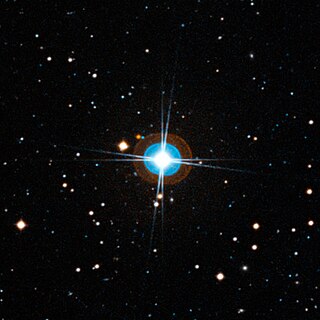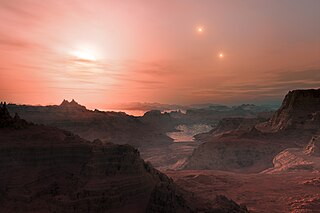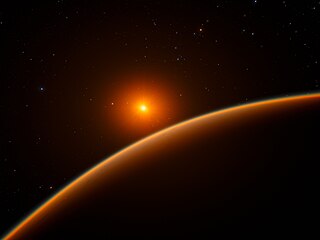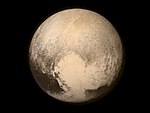Related Research Articles
GJ 1061 is a red dwarf star located 12 light-years from Earth in the southern constellation of Horologium. Even though it is a relatively nearby star, it has an apparent visual magnitude of about 13, so it can only be seen with at least a moderately-sized telescope.

Gliese 581b or Gl 581b is an exoplanet orbiting within the Gliese 581 system, located 20.5 light-years away from Earth in the Libra constellation. It is the first planet discovered of three confirmed in the system so far, and the second in order from the star.

A Super-Earth or super-terran or super-tellurian is a type of exoplanet with a mass higher than Earth, but substantially below those of the Solar System's ice giants, Uranus and Neptune, which are 14.5 and 17.1 times Earth's, respectively. The term "super-Earth" refers only to the mass of the planet, and so does not imply anything about the surface conditions or habitability. The alternative term "gas dwarfs" may be more accurate for those at the higher end of the mass scale, although "mini-Neptunes" is a more common term.

HD 10180, also designated 2MASS J01375356-6030414, is a Sun-like star in the southern constellation Hydrus that is notable for its large planetary system. Since its discovery, at least six exoplanets have been observed orbiting it, and some studies have proposed up to nine potential planets, which would make it potentially the largest of all known planetary systems, including the Solar System.

An exoplanet is a planet located outside the Solar System. The first evidence of an exoplanet was noted as early as 1917, but was not recognized as such until 2016; no planet discovery has yet come from that evidence. What turned out to be the first detection of an exoplanet was published among a list of possible candidates in 1988, though not confirmed until 2003. The first confirmed detection came in 1992, with the discovery of terrestrial-mass planets orbiting the pulsar PSR B1257+12. The first confirmation of an exoplanet orbiting a main-sequence star was made in 1995, when a giant planet was found in a four-day orbit around the nearby star 51 Pegasi. Some exoplanets have been imaged directly by telescopes, but the vast majority have been detected through indirect methods, such as the transit method and the radial-velocity method. As of 24 July 2024, there are 7,026 confirmed exoplanets in 4,949 planetary systems, with 1007 systems having more than one planet. This is a list of the most notable discoveries.

Gliese 667 Cc is an exoplanet orbiting within the habitable zone of the red dwarf star Gliese 667 C, which is a member of the Gliese 667 triple star system, approximately 23.62 light-years away in the constellation of Scorpius. The exoplanet was found by using the radial velocity method, from radial-velocity measurements via observation of Doppler shifts in the spectrum of the planet's parent star. Gliese 667 Cc is sometimes considered as the first confirmed exoplanet with a high prospect for habitability.
Kepler-62d is the third innermost and the largest exoplanet discovered orbiting the star Kepler-62, with a size roughly twice the diameter of Earth. It was found using the transit method, in which the dimming that a planet causes as it crosses in front of its star is measured. Its stellar flux is 15 ± 2 times Earth's. Due to its closer orbit to its star, it is a super-Venus or, if it has a volatile composition, a hot Neptune, with an estimated equilibrium temperature of 510 K, too hot to sustain life on its surface.
Kepler-61b is a super-Earth exoplanet orbiting within parts of the habitable zone of the K-type main-sequence star Kepler-61. It is located about 1,100 light-years from Earth in the constellation of Cygnus. It was discovered in 2013 using the transit method, in which the dimming effect that a planet causes as it crosses in front of its star is measured, by NASA's Kepler spacecraft.
HD 219134 d, also known as HR 8832 d, is an exoplanet orbiting around the K-type star HD 219134 in the constellation of Cassiopeia. It has a minimum mass over 16 times that of Earth, indicating that it is likely a Hot Neptune. The exoplanet was initially detected by the instrument HARPS-N of the Italian Telescopio Nazionale Galileo via the radial velocity method. Unlike HD 219134 b and HD 219134 c it was not observed by the Spitzer Space Telescope and thus its radius and density are unknown. Only a minimum possible radius can be given.
HD 219134 g, also known as HR 8832 g, is an unconfirmed exoplanet orbiting around the K-type star HD 219134 in the constellation of Cassiopeia. It has a minimum mass of 11 or 15 Earth masses, suggesting that it is likely a Neptune-like ice giant. Unlike HD 219134 b and HD 219134 c it is not observed to transit and thus its radius and density are unknown. If it has an Earth-like composition, it would have a radius 1.9 times that of Earth. However, since it is probably a Neptune-like planet, it is likely larger.

Wolf 1061 c is an exoplanet orbiting within the habitable zone of the red dwarf star Wolf 1061 in the constellation Ophiuchus, about 14.1 light-years from Earth. At the time of discovery, it was the closest known potentially habitable exoplanet to Earth, though several closer ones have since been found. It is the second planet in order from its host star in a triple planetary system, and has an orbital period of 17.9 days. Wolf 1061 c is classified as a super-Earth exoplanet as its mass is between that of Earth and the ice giants.

LHS 1140 b is an exoplanet orbiting within the conservative habitable zone of the red dwarf LHS 1140. Discovered in 2017 by the MEarth Project, LHS 1140 b is about 5.6 times the mass of Earth and about 70% larger in radius, putting it within the super-Earth category of planets. It was initially thought to be a dense rocky planet, but refined measurements of its mass and radius have found a lower density, indicating that it is likely an ocean world with 9-19% of its mass composed of water. LHS 1140 b orbits entirely within the star's habitable zone and gets 43% the incident flux of Earth. The planet is 49 light-years away and transits its star, making it an excellent candidate for atmospheric studies with ground-based and/or space telescopes.

Ross 128 b is a confirmed Earth-sized exoplanet, likely rocky, that is orbiting near the inner edge of the habitable zone of the red dwarf star Ross 128, at a distance of 11.007 light-years from Earth in the constellation of Virgo. The exoplanet was found using a decade's worth of radial velocity data using the European Southern Observatory's HARPS spectrograph at the La Silla Observatory in Chile. Ross 128 b is the nearest exoplanet around a quiet red dwarf, and is considered one of the best candidates for habitability. The planet is only 35% more massive than Earth, receives only 38% more starlight, and is expected to be a temperature suitable for liquid water to exist on the surface, if it has an atmosphere.
Luyten b is a confirmed exoplanet, likely rocky, orbiting within the habitable zone of the nearby red dwarf Luyten's Star. It is the fourth-closest potentially habitable exoplanet known, at a distance of 12 light-years. Only Proxima Centauri b, Ross 128 b, and GJ 1061 d are closer. Discovered alongside Gliese 273c in June 2017, Luyten b is a super-Earth of around 2.89 times the mass of Earth and receives only 6% more starlight than Earth, making it one of the best candidates for habitability.

K2-288Bb is a super-Earth or mini-Neptune exoplanet orbiting in the habitable zone of K2-288B, a low-mass M-dwarf star in a binary star system in the constellation of Taurus about 226 light-years from Earth. It was discovered by citizen scientists while analysing data from the Kepler space telescope's K2 mission, and was announced on 7 January 2019. K2-288 is the third transiting planet system identified by the Exoplanet Explorers program, after the six planets of K2-138 and the three planets of K2-233.
Kepler-737b is a super-Earth exoplanet 669 light years away. There is a chance it could be on the inner edge of the habitable zone.
TOI-2257 b is an extremely eccentric (0.496) exoplanet in or near the circumstellar habitable zone of the star TOI-2257, 188 light-years away. It is likely a sub-Neptune exoplanet, with a mass of 5.71 Mearth and a radius of 2.19 Rearth. As a small planet in the habitable zone, it is included in the Planetary Habitability Laboratory's list of potentially habitable exoplanets.

Gliese 414 Ac, or GJ 414 Ac, is an exoplanet orbiting Gliese 414 A, a K-type main-sequence star located 39 light-years from Earth, in the constellation Ursa Major. It is classified as a super-Neptune exoplanet, being at least 54 times more massive than the Earth and about 8.5 times larger. Gliese 414 Ac orbits its parent star at a distance of 1.4 astronomical units and completes one revolution around it every 2 years and 20 days. It is one of the two planets orbiting Gliese 414 A, the other is Gliese 414 Ab, a sub-Neptune.

Gliese 414 Ab, also known as GJ 414 Ab, is a sub-Neptune exoplanet orbiting Gliese 414 A, an orange dwarf located 39 light-years from Earth, in the constellation Ursa Major. It is at least 7.6 times more massive than the Earth and is 3 times larger, having a diameter of 37600 km. It orbits its host star at a distance of 0.24 astronomical units (36,000,000 km), completing one revolution every 51 days. The distance of Gliese 414 A b from its star makes it to be located in the inner part of the optmistic habitable zone, and the planet has a equilibrium temperature of 35.5 °C.
References
- 1 2 3 4 5 6 Astudillo-Defru, Nicola; Forveille, Thierry; Bonfils, Xavier; Ségransan, Damien; Bouchy, François; Delfosse, Xavier; et al. (2017). "The HARPS search for southern extra-solar planets. XLI. A dozen planets around the M dwarfs GJ 3138, GJ 3323, GJ 273, GJ 628, and GJ 3293". Astronomy and Astrophysics. 602. A88. arXiv: 1703.05386 . Bibcode:2017A&A...602A..88A. doi:10.1051/0004-6361/201630153. S2CID 119418595.
- ↑ "Planet reality check". 19 December 2015. Retrieved 2015-12-20.



